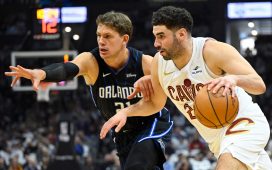Wat Misaka, the son of Japanese immigrants, was a 5-foot-7 guard who starred for the University of Utah on teams that won two national tournament championships at Madison Square Garden in New York and then joined the Knicks there in 1947.
The Knicks featured Misaka’s photo in an advertisement promoting their season opener, describing him as a “sensational defensive player.” But he was released after only three games, apparently considered too small for the pros.
Misaka then slipped into obscurity for decades, only to be ultimately recognized as a pioneer — as the first person of color to play in modern professional basketball. He died on Wednesday in Salt Lake City at 95, the University of Utah announced.
Misaka put on a Knick uniform only months after Jackie Robinson had broken the modern major league baseball color barrier with the Brooklyn Dodgers. At the time, the Knicks were part of the Basketball Association of America, a forerunner of the National Basketball Association, which counts the B.A.A.’s statistics as part of its history.
He became a Knick three years before Earl Lloyd joined the Washington Capitols as the N.B.A.’s first black player, 55 years before Yao Ming of the Houston Rockets became the league’s first Chinese star, and 65 years before the Knicks’ Jeremy Lin, of Taiwanese background, created a brand of fan excitement called Linsanity.
In interviews over the years, Misaka did not recall any ethnic animosity toward him by Knick teammates or opposing players during his brief N.B.A. stint. But he did experience discrimination off the court.
Misaka’s college coach, Vadal Peterson, had joined him for contract talks with Ned Irish, the Knicks’ president, at the Hotel Utah in Salt Lake City.
“I’d never think of registering at” the hotel, Misaka told ESPN The Magazine decades later. “They didn’t let nonwhites stay there.”
Misaka said the only player he had been close to during training camp was his roommate, Carl Braun, the future Knicks star.
“I wouldn’t go into a nice restaurant without my teammates,” he said. “I wouldn’t go out much at all. It was just basketball, eat, sleep.
“Actually,” he continued, “the New York fans were probably better than the fans back home. But I still heard a few yell, ‘Jap, go home.’ And they weren’t talking about Utah.”
Playing for the Knicks in their second season in the B.A.A., Misaka scored only seven points in three games before being cut.
“He got so much out of what he had, but to put someone in that size is difficult,” Braun once told The New York Times.
Misaka seemed bemused by the attention he began to receive long after his basketball career had ended.
“It’s kind of strange,” he told NBA.com. “My parents were Japanese. But in my entire career I played with whites, so I just feel like I’m just like the rest. The way it was and the way they treated me, I was just another basketball player.”
Wataru Misaka was born on Dec. 21, 1923, in Ogden, Utah, to Fusaichi and Tatsuyo Misaka. His parents owned a barber shop.
He played for two seasons at Weber State College (now Weber State University) in Ogden, then transferred to the University of Utah in Salt Lake City. His family was spared internment during World War II, since relocation was confined to people of Japanese descent who lived on the West Coast.
With military service depleting basketball teams’ rosters, Misaka sparked a Utah squad made up largely of freshmen to a stunning 42-40 overtime victory in the 1944 N.C.A.A. tournament final over a Dartmouth team that had many top players enrolled in a Navy training program there.
Misaka “was so well received in New York,” Utah’s star forward Arnie Ferrin once told Sports Illustrated. “The port was closed, and there were troopships there, but people responded to how hard he played.”
Wisaka served in the Army afterward, then returned to Utah.
In the 1947 final of the National Invitation Tournament, his smothering defensive play held the All-American guard Ralph Beard to a single point in Utah’s 45-40 upset of Kentucky.
As The Times put it, “Little Wat Misaka, American born of Japanese descent, was a ‘cute’ fellow intercepting passes and making the night miserable for Kentucky.”
“The crowd was really rooting for me,” Misaka told NPR long afterward. “It was right after the war. There didn’t seem to be people holding that against my ancestors.”
He recalled: “I felt less prejudice against me in New York than I did anywhere else. When I went back as a Knick, there were people who remembered me from playing for Utah and would say hello on the streets.”
After being released by the Knicks, Misaka returned to Utah to obtain his degree, then became a mechanical engineer in Salt Lake City.
Misaka and his wife, Katie, had a son, Henry; a daughter, Nancy Umemora; and grandchildren. A list of survivors was not immediately available.
He was recognized in 2000 in an exhibit of sports pioneers at the Japanese-American National Museum in Los Angeles, which displayed his University of Utah jersey and shorts and his Knick sneakers.
His life was recounted in the 2009 documentary “Transcending: The Wat Misaka Story,” by Bruce Alan Johnson and Christine Toy Johnson. He returned to the Garden in August 2009 for a remembrance of his time as a Knick. President Barack Obama invited him to a ceremony in 2009 re-establishing a presidential advisory commission on issues involving Asian-Americans.
Misaka felt a kinship with Lin, offering encouragement when he was struggling with the Golden State Warriors in the 2010-11 season before his spectacular, if brief, run as a Knick. (Lin is now playing for the Beijing Ducks of the Chinese Basketball Association.)
“Jeremy Lin seemed like a good kid in a dark and gloomy time,” Misaka told Sports Illustrated. “I wrote him a note of encouragement and just told him to hang in there.”








